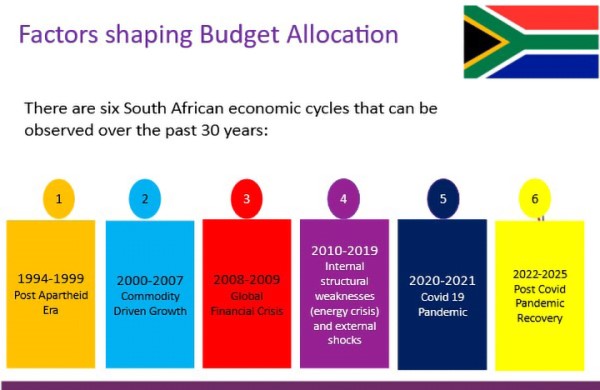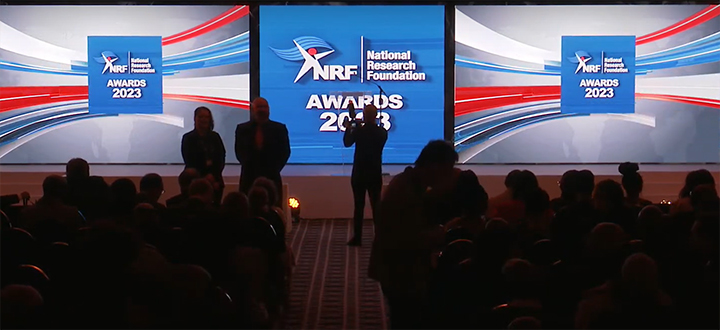College of Graduate School of Business Leadership
Unisa SBL CEO provides early insights into the 2025 Budget Speech
In the latest instalment from the SBL CEO Leadership Dialogues series, Prof Pumela Msweli, Executive Dean and CEO of the Unisa Graduate School of Business Leadership (SBL), makes predictions on the upcoming 2025 Budget Speech using historical data from 1994 to 2024. Msweli analyses budget allocations over the past 30 years, applying the exponential smoothing forecasting technique to predict the 2025 budget allocations.

Prof Pumela Msweli hosts a webinar where she makes predictions on the upcoming 2025 Budget Speech
In order to understand the predictions, one needs to understand the factors that have shaped previous years’ budget allocations. Msweli groups the past 30 years into six observable economic cycles.
The Post-Apartheid Era from 1994 to 1999 was characterised by deep inequality, and a dire need for reconstruction and development. Budget allocation was therefore aimed at social spending to reduce inequality, fiscal discipline to reduce budget deficit and maintaining debt at management levels.
The Commodity Driven Growth Era from 2000 to 2007 was characterised by a growing middle class, improved fiscal management, and improved economic stability with an average growth rate of 4-5% and increased commodity prices which benefited South Africa, a country blessed with abundant natural resources to export.
The Global Financial Crisis Era from 2008 to 2009 saw a sharp drop in South Africa’s exports due to the decline in commodity prices. The value of the Rand also dropped due to foreign disinvestment. To stimulate growth, the South African government increased stimulus spending. Public debt rose and along with it, the need to maintain debt at management levels. This did little to address the existing challenges of high unemployment, inequality and poverty.
The period from 2010 to 2019 is labelled as the Internal Structural Weaknesses (energy crisis) and External Shocks Era. The economic factors that shaped budget allocation during this period were high unemployment, expanding social programmes aimed at poverty alleviation, bailouts for underperforming state-owned enterprises (SOEs) such as Eskom and SAA, and again, maintaining debt at manageable levels.
The fifth cycle is the 2020 to 2021 Covid-19 Pandemic Era where budget allocation was focused on topping up social grants and the release of large relief funds in the face of a massive worldwide pandemic. During this era, the debt to GDP ratio exceeded 70%.
The final cycle, the Post-Covid Pandemic Recovery Era, is marked by rising debt levels, economic growth, spending on infrastructure and more bailouts for SOEs.
Having examined the conditions which influenced budget allocations across the six cycles spanning 30 years from 1994 to 2024, attention is now turned to the 2025 State of the Nation Address that was delivered on 6 February 2025. In it, President Cyril Ramaphosa outlined three strategic government priorities, namely, to drive inclusive growth and job creation, to reduce poverty and tackle high cost of living, and lastly, but not least, to build a capable and ethical developmental state. It is predicted that the 2025 budget will be allocated according to these government priorities.

Factors shaping budget allocations over the past 30 years
To achieve the desired 3% economic growth rate and reduce unemployment, government aims to deploy monitory, fiscal and structural policy instruments to stimulate the economy. It is hoped that the application of these instruments will shift the needle on key economic performance indicators such as GDP, unemployment, public debt and the exchange rate, among other indicators.
Using exponential smoothing, Msweli therefore makes the following predictions on the 2025 budget:
- Social grants are likely to be allocated a budget of over R175 billion
- Education can expect an allocation of approximately R320 billion
- Health care will receive an allocation of approximately R260 billion
- Public sector wages could see an allocation of around R650 billion
- The infrastructure budget might exceed R940 billion.
- There will likely be a significant increase in debt services costs and value added tax, while corporate tax (revenue) and personal income tax are not expected to see any changes
The Unisa Graduate School of Business Leadership takes the lead in providing these early insights in order to demonstrate thought leadership and to empower stakeholders, including students and alumni, with relevant, current and impactful knowledge.
* Compiled by Thami Kaunda, Unisa SBL Communication Specialist
Publish date: 2025/02/18

 Unisa co-hosts G20 community outreach in the Eastern Cape
Unisa co-hosts G20 community outreach in the Eastern Cape
 Unisans gain membership of prestigious science academies
Unisans gain membership of prestigious science academies
 Advocating for disability transformation through servant leadership
Advocating for disability transformation through servant leadership
 Unisa Press continues to illuminate the publishing space
Unisa Press continues to illuminate the publishing space